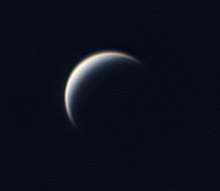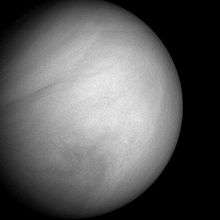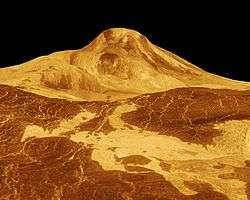Venera 3
 | |
| Mission type | Venus atmospheric probe with flyby spacecraft |
|---|---|
| Operator | OKB-1 |
| COSPAR ID | 1965-092A |
| SATCAT no. | 1733 |
| Mission duration | 105 days |
| Spacecraft properties | |
| Spacecraft | 3MV-3 No.1 |
| Manufacturer | Lavochkin |
| Launch mass | 960 kg (2,120 lb) |
| Landing mass | 377 kg (831 lb) |
| Dimensions | 4.2 m × 1.1 m (13.8 ft × 3.6 ft) |
| Start of mission | |
| Launch date | 16 November 1965, 04:19 UTC |
| Rocket | Molniya M |
| Launch site | Baikonur 31/6 |
| Orbital parameters | |
| Reference system | Heliocentric |
| Perihelion | 0.68 AU |
| Aphelion | 0.99 AU |
| Inclination | 4.29° |
| Period | 277 days |
| Venus impact (failed landing) | |
| Impact date | 1 March 1966 |
| Impact site | 20°N 80°E / 20°N 80°E |
Venera 3 (Russian: Венера-3 meaning Venus 3) was a Venera program space probe that was built and launched by the Soviet Union to explore the surface of Venus. It was launched on 16 November 1965 at 04:19 UTC from Baikonur, Kazakhstan, USSR. The probe comprised an entry probe, designed to enter the Venus atmosphere and parachute to the surface, and a carrier/flyby spacecraft,[1][2] which carried the entry probe to Venus and also served as a communications relay for the entry probe.
History
During 1965, the Central Committee, frustrated at the poor track record of Sergei Korolev's OKB-1 design bureau, reassigned the planetary probe program to the Lavochkin Bureau. In over two dozen attempts dating back to 1958, Luna 2 and Luna 3 were the only probes to complete all of their mission objectives. In the meantime, the United States had succeeded with the Mariner 2 Venus probe and Mariner 4 Mars probe, and after a long string of lunar probe failures, Ranger 6 successfully impacted on the Moon (with a failed TV system), and Ranger 7 successfully sent back a series of TV pictures.
The Lavochkin Bureau began a comprehensive testing program of the Venera and Luna probes, while Korolev had always opposed the idea of bench tests except on manned spacecraft. Among other design flaws they discovered was that the Venera landers, after being subjected to a centrifuge test, failed at half the G forces that they were supposed to handle.
Mission
The mission of this spacecraft was to land on the Venusian surface. The entry body contained a radio communication system, scientific instruments, electrical power sources, and medallions bearing the Coat of Arms of the Soviet Union.
The entry probe possibly crashed on Venus on 1 March 1966, possibly making Venera 3 the first space probe to hit the surface of another planet. However, its communications systems had failed before it reached Venus.[3][4]
Instruments
Power system
The power system for the carrier spacecraft was notable in that it was the first operational use of Gallium Arsenide (GaAs) solar cells in space. GaAs solar cells, manufactured by Kvant, were chosen because of their higher performance in high temperature environments.[5] Two two-square-meter solar panels charged the rechargeable batteries.
The entry probe was battery powered using non-rechargeable batteries
Non-scientific equipment
- Transmitters and receivers at UHF frequency;
- Telemetry switches;
- System of alignment and correction station movement: micromotors, gas jets, electrooptical probe position sensors, and gyroscopes;
- Computer controller of all probe systems.
Scientific equipment
- Three flux-gate magnetometer to measure interplanetary magnetic fields;
- Discharge counters and semiconductor detector for the study of cosmic rays;
- Special sensors (traps) to measure the flow of charged particles and determination of low energy consumption of the amounts of solar plasma flows and their energy spectra;
- Piezoelectric sensors for research micrometeorites;
- Measurement of emissions of cosmic radio in the wavelength intervals of 150 and 1500 meters and to 15 km.[6]
See also
References
- ↑ Mark Wade, Venera 3MV-3, Austronautix.com. Retrieved 3 April 2018.
- ↑ Gunter Krebs, Venera 3 (3MV-3 #1), Gunther's Space Page. Retrieved 3 April 2018.
- ↑ David Leverington (2000). New cosmic horizons. Cambridge University Press. p. 74. ISBN 0-521-65833-0.
- ↑ "Venera 3". NASA.
- ↑ G.F.X. Strobl, G. LaRoche, K.-D. Rasch, and G. Hey, "2 From Extraterrestrial to Terrestrial Applications," in High-Efficient Low-Cost Photovoltaics: Recent Developments, Springer 2009.
- ↑ The interplanetary space probes "Venera-2" and "Venera-3" (in Russian). Retrieved 17 February 2017.
| Wikimedia Commons has media related to Venera 3. |


